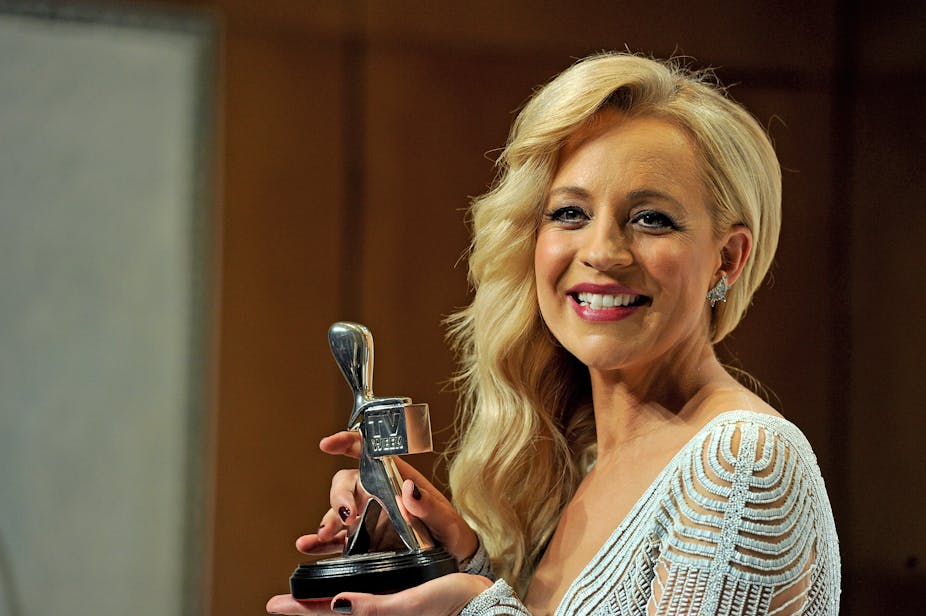In the acceptance speech for her Gold Logie (for the most popular Australian television personality), Carrie Bickmore, who is a presenter on Network 10’s The Project, sought to raise awareness of the apparent under-funding of brain cancer research.
While I can’t fault Bickmore for trying to get attention for the disease that prematurely killed her husband, her move does raise questions about how research should be funded.
Cancer Australia has compared research funding for brain cancer to funding for other cancers, based on the burden of each in terms of years of healthy lives lost. It found brain cancer receives approximately half as much funding as these other cancers.
So, is this a sign that Australia’s research funding system is unfair? Well, probably. But not necessarily to the disadvantage of brain cancer research.
A clever umbrella
In environmental ethics, there is a concept known as umbrella species, which functions like this: suppose in a local environment, there’s a desperately endangered slug and a somewhat endangered small furry critter – say a wombat of some kind.
A savvy environmentalist focuses attention on the plight of the wombat, knowing that measures taken to protect them and their environment will incidentally protect the more critically endangered slug. Because she knows people are considerably more willing to devote time and resources to saving small furry critters than slugs. So the wombat serves as an umbrella to protect the slug.
In this context, cancer is the umbrella species since, in general, it receives considerable funding, attention and focus. When the Abbott government first mentioned its plan to start a medical research future fund, for instance, cancer was one of the diseases the money was supposed to help find a cure for.
This kind of thinking is reflected in researcher attitudes as well; I often have colleagues complain that they would receive much more funding if they worked on the “Big C”. This probably accounts for the fact that between 2003 and 2011, brain cancer research funding increased a whopping 653% - rising from A$1.5 million to A$11.3 million. Not bad for a neglected disease.
The right way
There are three main sources of health and medical research funding in Australia: government funding, predominantly though not exclusively through the National Health and Medical Research Council (NMHRC), philanthropic funding, and for-profit funding through private (usually international) companies.
The primary mode we tend to consider is NMHRC funding, because this is public money and so is accountable in ways other funding is not.
NHMRC’s research funding is predominantly distributed on the basis of the quality of research proposals, independent of specific diseases being addressed – although the impact of the research is also taken into consideration.
This seems like a sensible and fair way to evaluate which research projects get funded. And we should be sceptical, I think, of both well-meaning celebrity calls for a specific focus in funding and of governmental interference in funding priorities.
One doesn’t need to look further than the way the current government tried to use the establishment of a medical research fund to force through their regressive introduction of co-payments for GP visits to understand why.
An even more telling example is the conservative UK government’s establishment of a Cancer Drugs Fund to pay for cancer treatment that would not normally be funded by the country’s public health system, the National Health Service (NHS).
By definition, this was bad use of funds for political purposes since treatments that weren’t funded by the NHS were those found to not be cost-effective. The redirection of resources in the UK health-care system towards treatment of the “Big C” will likely lead to more illness and death because scarce health-care resources are being used inefficiently.
Well meant but…
Should the burden of a disease then be a deciding factor in health research funding distribution? Definitely, but it shouldn’t be the only consideration if we want funding distribution to promote fairness and better health outcomes.
We also need to take the likely impact of research funding on people who are socially disadvantaged into consideration. This may mean we need a stronger research focus on public health and health-care distribution, rather than “sexy” new treatments.
Likewise, we ought to consider the impact of research results on cost effectiveness. Right now, too much focus is arguably spent on curing without consideration of the cost of new treatments. But if we can increase the cost effectiveness of treatments, we can help more people, which surely must be the aim of medical research.
None of this is to say that brain cancer doesn’t deserve more research funding, nor that celebrities oughtn’t use their public platform to raise awareness of particular diseases. Rather that speeches like Bickmore’s should be the start of a conversation about what is funded, not its conclusion.
Working out a fair distribution of research funds is considerably more complex than just comparing the amounts of research funding particular diseases receive.

